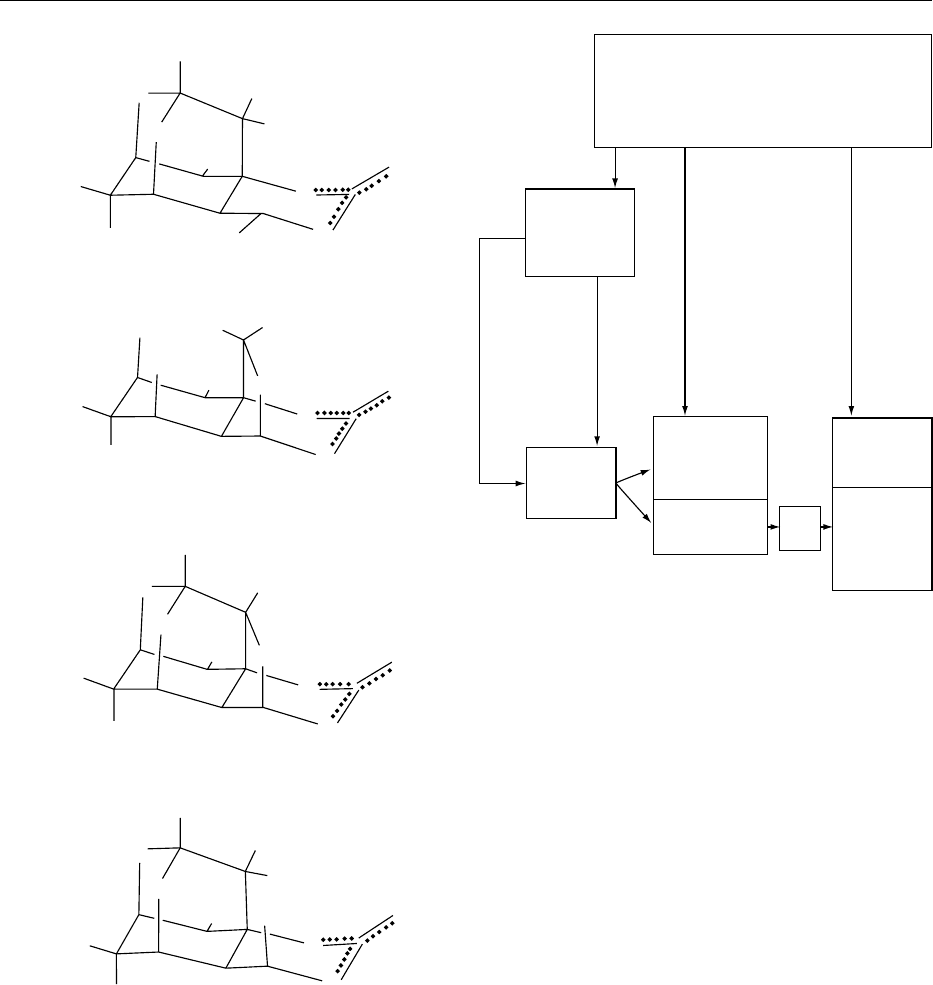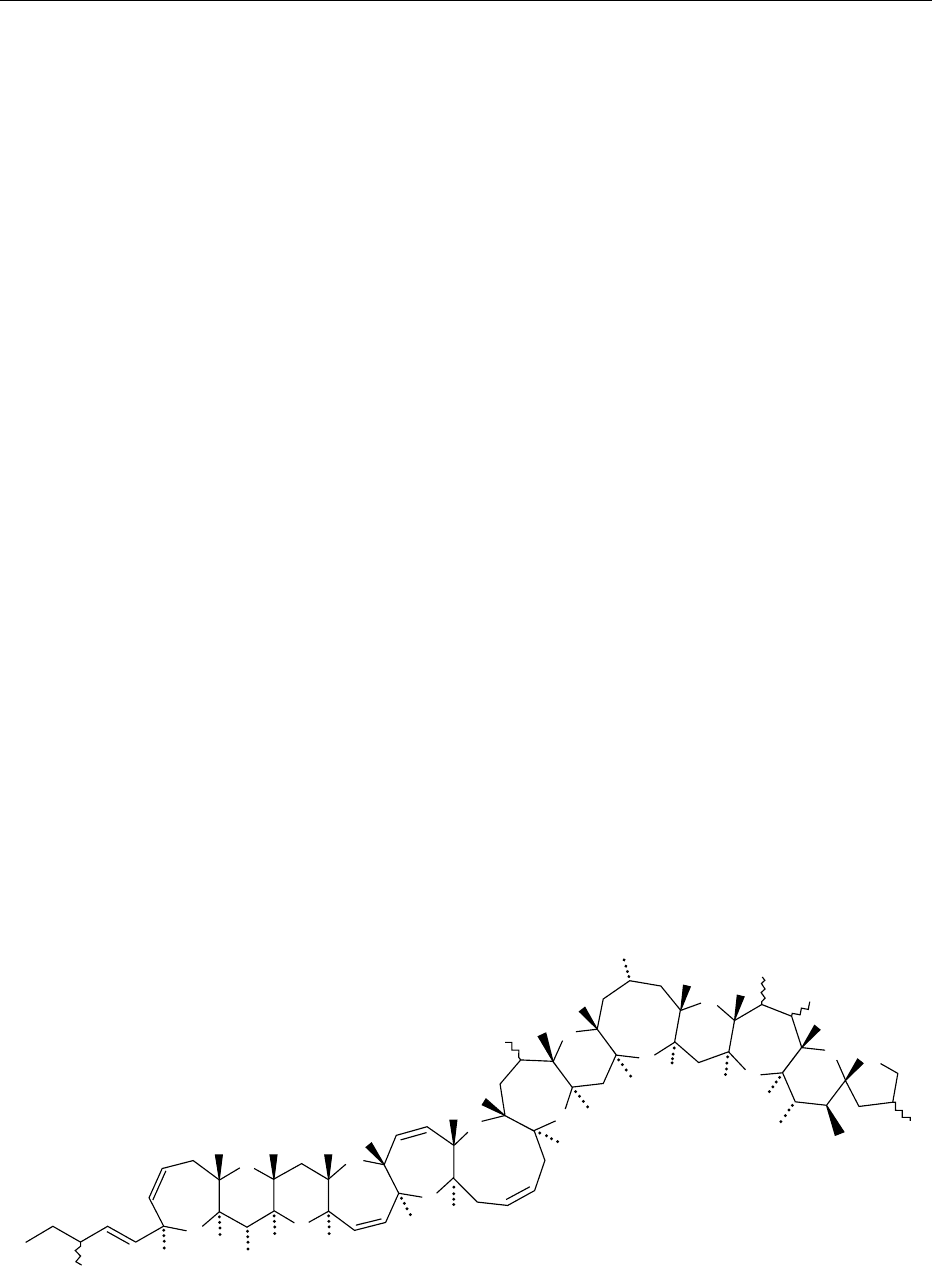Caballero B. (ed.) Encyclopaedia of Food Science, Food Technology and Nutrition. Ten-Volume Set
Подождите немного. Документ загружается.


marine oils have been related to prevention of heart
disease is noteworthy in modern Western societies
conscious of their health, and the consumption of
seafood is increasing significantly. (See Fish Oils:
Dietary Importance; Shellfish: Commercially Import-
ant Crustacea; Commercially Important Molluscs.)
0002 The majority of fish and shellfish are safe as food,
but there are some species that are naturally toxic
or poisonous and may cause illness or even death if
they are consumed. This article reviews raw-fish
dishes of Japan (e.g., Fugu), nature and risks from
ciguatoxins, caviar and its production, and eels and
their uses.
Raw-fish Dishes of Japan
0003 Raw-fish dishes – sliced fish flesh called sashimi in
Japan – have been served with vinegar for more than
1000 years, but are now more popular eaten with soy
sauce and grated Japanese horse radish. Flesh from
freshly caught fish is in the majority, but frozen–
thawed flesh is often supplied to the dishes. Bluefin
tuna (Thunnus thynnus), sea bream (Pagrosomus
major), striped bonito (Sarda orientalis), yellowtail
(Seriola quinqueradiata), and flounder (Paralichthys
olivaceus) are the species mostly consumable in all
seasons, and tiger puffer (Fugu rubripes) is considered
a prize delicacy in winter. The flesh for the dishes
should be of top quality regarding color, flavor,
taste, and texture.
0004Freshly caught bluefin tuna and striped bonito are
normally subjected to deep freezing, at a temperature
as low as 45
C, at sea to prevent myoglobin, the
dominant pigment in fish muscle, from turning to
metmyoglobin, which is a cause of meat discolor-
ation. Thus, the thawed flesh of deep-frozen tuna
and bonito is suitable to be served as raw-fish dishes.
0005More than 100 species of puffer fishes (family
Tetrodontidae) are broadly distributed from temper-
ate to tropical waters, but only about 10 species have
been consumed as human food by a handful of coun-
tries, principally Japan. There are marked differences
in toxicity among species, some being virtually non-
toxic. Fresh flesh and some parts of the puffer fish
may be enjoyed as raw or cooked dishes if properly
prepared, but other parts, such as ovary and liver, are
extremely toxic (Table 1). Only licensees may prepare
and serve dishes of the puffer fish for consumers,
under conditions specified by the Ministry of Health
and Welfare, because the major cause of food-
poisoning deaths is ingestion of toxic puffer fishes.
0006The responsible toxins are tetrodotoxin (TTX) and
related compounds (Figure 1). The lethal dose of TTX
for people is estimated to be 10 000 mouse units,
equivalent to 2 mg of TTX. Poisoning as a result of
eating puffer fishes is serious, and causes neurological
symptoms: tingling in the lips and extremities, paraly-
sis, and death by respiratory arrest and cardiovascular
collapse. The cardiovascular effects account for the
relatively high lethal rate in puffer-fish intoxications.
tbl0001 Table 1 Toxicity of puffer fishes
Species Ovary Testes Liver Skin Intestine Muscle
Fugu niphobles AC ABA C
F. poecilonotum AB ABB C
F. v e r m i c u l a r e v e r m i c u l a r e AD ABB C
F. pardale AC ABB D
F. vermiculare porphyreum AD ABB D
F. ocellatus obscurum AD BBB D
F. chrysops BD BBC D
F. rubripes rubripes BD BDC D
F. xanthopterum BD BDC D
F. stictonotum BD BCD D
Lagocephalus laevigatus inermis DD BDD D
L. lunaris spadiceus DD DDD D
Liosaccus cutaneus DD DDD D
Canthigaster rivulata DN CBC D
Diodon holacanthus DN DDD D
Chilomycterus affinis DN DDD D
Ostracion immaculatum DD DDD D
Lactoria diaphana DD DDD D
Aracana aculeata DD DDD D
A, strongly toxic, lethal at less than 10 g; B, moderately toxic, not lethal at less than 10 g; C, weakly toxic, not lethal at less than 100 g; D, negative, not
lethal at less than 1000 g; N, no data available.
Data from Hashimoto Y (1987) Marine Toxins and other Bioactive Marine Metabolites. Tokyo: Japan Scientific Societies Press.
2458 FISH/Miscellaneous Fish Products

0007 TTX has been demonstrated to be produced by
intestinal bacteria of TTX-bearing animals, as well
as some species of marine bacteria. This fact, along
with the distribution of TTX in nature, made it
possible to suggest the mechanism involved in the
toxification of TTX-bearers (Figure 2).
0008Nontoxic or slightly toxic puffer fishes have been
successfully cultured, and an increase in demand is
likely.
Nature and Risks from Ciguatoxins
0009About 300 species of fish and shellfish, inhabiting
shallow waters around coral reefs, have been known
to cause ciguatera, a poisoning with unique symp-
toms. Fish apparently become toxic and lose the tox-
icity rather more slowly. Although the name ciguatera
is derived from the Spanish term for a marine snail,
the syndrome is currently recognized as the result of
consumption of certain tropical fish. The risk of
ciguatera is highest from the consumption of herbiv-
orous reef fish or of the carnivorous fish that feed
on them.
0010It is thought that the principal source of ciguatoxin,
the most important toxin, is the benthic dinoflagellate
Gambierdiscus toxicus, which tends to cluster on the
surfaces of certain tropical seaweeds. Because of this
growth habit, the benthic dinoflagellate is efficiently
accumulated by herbivorous reef fish. Ciguatoxin
was isolated from G. toxicus obtained directly from
O
O
O
O
O
−
O
O
O
O
−
O
H
H
H
NH
2
NH
2
NH
2
NH
2
N
N
N
N
N
N
N
N
H
H
H
H
H
H
H
H
+
+
+
+
H
OH
OH
OH
OH
OH
OH
OH
OH
OH
OH
OH
HO
Tetrodotoxin
Tetrodonic acid
Anhydrotetrodotoxin
4-epi-Tetrodotoxin
HOH
2
C
HOH
2
C
HOH
2
C
HOH
2
C
OH
COO
−
OH
O
−
fig0001 Figure 1 Structures of tetrodotoxin and related compounds.
From Nakamura M and Yasumoto T (1985) Tetrodotoxin deriva-
tives in puffer fish. To x i c o lo g y 23: 271–276, with permission.
TTX-
producing
marine
bacteria
TTX
dissolved
in sea
water
TTX
absorbed
on and
precipitated
with
planktonic
carcass,
etc.
TTX
in
sediment
Flatworm
Ribbonworm
Arrowworm
Xanthid crab
Small
gastropods
Star
fish
Puffer fish
Tropical
goby
Large
gastropods
such as
trumpet
shell
(Parasitism
or symbiosis)
Vibro alginolyticus
V. damsela
Staphylococcus
Bacillus spp.
Pseudomonas spp., etc.
fig0002Figure 2 Assumed mechanism of toxification of TTX-bearing
animals. From Noguchi T, Arakawa O and Hashimoto K (1989)
Tetrodotoxin with special reference to its origin and the mechan-
isms involved in toxification of puffers. Journal of the Food Hygiene
Society (Japan) 30: 281–288, with permission.
FISH/Miscellaneous Fish Products 2459

coral reef seaweeds. Cultures of G. toxicus, however,
have been found to produce primarily a different
toxin, maitotoxin, the structure of which is not yet
clarified. Other benthic dinoflagellates, with growth
habits and distributions similar to those of G. toxicus,
may also be involved. The known differences between
ciguatoxin and brevetoxin lie in the longer duration
of the effects of ciguatoxin in human victims. Symp-
toms are nausea and neurological deficits similar to
those of paralytic shellfish poisoning, but more severe
and enduring. Victims of ciguatera occasionally com-
plain of relapses, in some cases precipitated by con-
sumption of alcohol, for months or even years after
the initial attack. Deaths are rare. The neurological
dysfunction includes a reversal of the sensations of
hot and cold, called ‘dry-ice’ sensation. The distribu-
tion of ciguateric fish cannot be defined strictly, but
distinct zones of toxicity are known by local fisher-
men. In notorious carnivorous fish, such as barra-
cuda, which are capable of both migrating and
accumulating high levels of toxin, it would be diffi-
cult to discriminate toxic fish from others.
0011 Although the characterization of ciguatoxin has
been a long-standing matter owing to the complexity
of the molecule and the difficulty in obtaining ad-
equate material, instrumental analyses with purified
material have elucidated the complete structure
(Figure 3). Chromatographic evidence indicates that
several other related toxins are also involved in cigua-
tera poisoning.
Caviar and its Production
0012 The eggs of many fish species, and of some other
aquatic animals such as sea urchin, are sought as a
food item. Caviar is one of the most well-known
names, especially in connection with sturgeon (Aci-
penser medirostris) eggs. Caviar and other fish egg
products are considered a specialty food and thus
tend to bring a high price.
0013Fish eggs have a substantial food value. On a
dry-weight basis, eggs contain 45–48% protein,
11–32% lipid, and 1.3–4.5% ash, respectively. To
produce caviar, live mature fish have to be used;
from dead sturgeon, it is difficult to remove the
eggs as they adhere firmly to the ovary sac. The
belly is cut open, from the pectoral fins to the anus.
The ovary is then drawn out and processed
immediately. The general procedure used in caviar
processing begins with washing the ovaries to remove
most of the blood and slime. The ovaries are then
cut open to extract the eggs. The egg-membrane
tissue of the sturgeon is normally hyperplasic and
muscular, but it can be softened enzymatically by
the action of lysozyme. The eggs are typically
salted, using either dry salting or a salt brining. For
dry salting, 10% (w/w) of salt is added to the
eggs as they are passed through a 33-mm sieve; stir-
ring may ensure faster and more effective penetration
of the salt into the eggs. After 3 h of salting, the
eggs are drained on a wire net. In the case of salt
brining, the eggs are allowed to stand for 1 h in
saturated brine, then drained upon a wire net over-
night. For further dehydration, the salted eggs
are pressed in a cotton bag. The salt-cured eggs are
packed in a container, tightly sealed, and stored at
5
C for aging.
0014Salted salmon eggs are called red caviar. The qual-
ity of red caviar depends on species, maturity, and
freshness of the eggs. The eggs should be of spawning
HO
OH
H
O
O
O
O
O
O
O
H
H
H
H
H
H
H
OH
OH
H
HHH
H
H
H
HH
OH
H
H
H
HO
O
O
O
O
O
O
H
H
fig0003 Figure 3 Structure of ciguatoxin. From Murata M, Legrand AM, Ishibashi Y and Yasumoto T (1989) Structure of ciguatoxin and its
congener. Journal of the American Chemistry Society 111: 8929–8931, with permission.
2460 FISH/Miscellaneous Fish Products

salmon caught from coastal waters and be extracted
within 2 h of catching. Egg-membrane tissue in a
mature ovary is naturally hyperplasic and muscular,
and results in a low-quality product. It is also inad-
equate if eggs are used from the salmon late in the
fishing season, or immediately before spawning. A
high-quality red caviar is attributed to the use of
eggs of pink salmon (Oncorhynchus masou).
0015 Once separated from the raw salmon, the ovaries
are washed thoroughly in fresh water to remove
blood vessels and slime, then rubbed through a
gauze cotton net to isolate the eggs. An apparatus
consisting of gauze cotton net, a sloping wire net,
and a receiver is useful for commercial purposes.
The eggs that have been separated through the
gauze cotton net run down the slope and fall into
the receiver. The mass accumulated in the receiver is
put into a tub containing saturated salt brine (which
has been boiled and cooled prior to use), stirred for
20 min, removed and put into a basket, drained for
24 h, packed in a barrel or a wooden box, and cold-
stored for aging.
0016 The oil content of salmon eggs averages 12% on
the basis of total weight. Salmon eggs yield a light-
colored oil. The oil contains about 45% of highly
unsaturated fatty acids with molecules having 20–22
carbon atoms. About one-third of the total fat is
phospholipid, probably lecithin. The protein of
salmon eggs is of a high quality. It contains all of the
eight essential amino acids (isoleucine, leucine, lysine,
methionine, phenylalanine, threonine, tryptophan,
and valine) in substantial amounts. Salmon egg
protein is relatively high in lysine, methionine, and
isoleucine. (See Amino Acids: Metabolism.)
Eels and their Uses
0017 Eels are difficult to sell in the USA but are highly
prized in Europe and several areas of the Far East,
including Japan. The major species of food eels are
freshwater eels (Anguillidae), pike eels (Muraensoci-
dae) and conger eels (Congridae). Of the 16 species of
Anguilla eels found worldwide, most are in the waters
around Southeast Asia. Anguilla japonica and A. mar-
morata are the inhabitants in the waters around
Japan, while A. rostrata and A. anguilla are in
the Atlantic. For food eels, the important species are
A. japonica and A. anguilla. Muraenesox cinereus is
the commercially valuable species of pike eel. Conger
eels number about 110 species in the world, but
white-spotted conger (Conger myriaster) is the only
species prized as food. Eels are mostly processed to
produce ‘spitchcock’ with seasoning juice. Eels
weighing roughly 200 g are put into a basket and
subjected to cut-feed for a couple of days in running
water. In producing ‘spitchcock,’ back-cutting, meat
separating, and sizing are the initial processes, per-
formed manually. The spiting and broiling processes
are carried out mostly by machines.
0018In the broiling process, an infrared ray burner is
commonly used. The broiling time depends on the
flame temperature and the size of the slices of flesh,
but generally, 4–5 min is long enough for the first
broiling without seasoning juice, then 5–10 min for
the second broiling with the juice. A seasoning juice is
brushed over the flesh surface during an automated
run from the first to the second broiling processes.
The broiling process greatly affects the food quality:
either insufficient or excessive broiling gives a bitter
or burnt flavor to the product. The seasoning juice
consists of soy sauce, sugar, and sweet liquor, in a
ratio of 1:1:0.5.
0019Smoked eel is another type, traditionally popular
in Europe, and is widely consumed. Preliminaries for
processing smoked eels are almost similar to those for
‘spitchcock.’ The fresh fillets are cured in 5–10% salt
brine for about 10 h; salt concentration and curing
time are controlled according to the size of the fillet.
The cured fillets are then subjected to trimming,
washing, draining, and drying. Smoke drying is im-
portant in processing smoked eel and is performed at
a controlled temperature within 60–80
C for 5–6h,
using hardwood or sawdust. A gradual increase in
temperature, using adequate amounts of sawdust,
is required to prevent the flesh from scorching.
The half-finished product is taken out from the
smoking kiln, any soot is swept off, and the fillets
are arranged in a carton box to equalize the water
contents.
0020The ‘spitchcock’ eels are the traditional food of
Japanese people during the hottest period of the
summer. They contain (per 100 g of eel) 47.1 g of
water, 23.0 g of protein, 24.4 g of lipid, 3.1 g of non-
fibrous carbohydrate, 2.4 g of ash, 150 mg of calcium,
300 mg of phosphorus, 0.8 mg of iron, 510 mg of
sodium, 300 mg of potassium, 150 mg of retinol,
5000 IU of retinol potency, 0.75 mg of thiamin,
0.74 mg of riboflavin, and 4.1 mg of niacin. Refer to
individual nutrients.
0021Pike eel is a white-flesh fish, which is rich in fat and
taste, and consumable as ‘spitchcock,’ soup, or
‘vinegared’ products, or, after processing, to surimi
(ground meat), as the base for a high-quality fish-gel
product. However, a number of tiny bones remaining
in the flesh are disadvantageous in processing any
type of marine food.
See also: Amino Acids: Metabolism; Fish Oils: Dietary
Importance; Shellfish: Commercially Important
Crustacea; Commercially Important Molluscs
FISH/Miscellaneous Fish Products 2461

Further Reading
Hall S (1991) Natural toxins. In: Word DR and Hack-
ney CR (eds) Microbiology of Marine Food Products,
pp. 301–330. New York: Van Nostrand Reinhold.
Motohiro T (1975) An elementary knowledge of frozen
food. In: Amano K, Kaneko S, Kameda K et al. (eds)
Handbook of Frozen Food, pp. 39–42. Tokyo: Asakura-
Shoten.
Tanikawa E, Motohiro T and Akiba M (1985) Marine
Products in Japan, 2nd edn. Tokyo: Koseisha Koseikaku.
Spoilage of Seafood
P Dalgaard, Technical University of Denmark, Lyngby,
Denmark
Copyright 2003, Elsevier Science Ltd. All Rights Reserved.
Background
0001 The world’s annual production in capture fisheries
has remained at * 90 million tonnes during the last
decade, and only aquaculture production in marine
and fresh water has allowed for global increases in
raw material for fishery products. At the same time,
international trade in seafood is increasing, and opti-
mal utilization of available resources and prevention
of losses during storage and distribution are more
important than ever. Most seafoods have a short
and variable shelf-life, and the increasing interest in
marketing of less preserved products makes preven-
tion of spoilage an important challenge.
0002 The flesh of most fresh fishes has a high pH of 6–7
post rigor and a high content of free amino acids in
the muscle extractives. Many marine and some fresh-
water species contain trimethylamine oxide (TMAO),
resulting in a high muscle redox potential, and some
species contain high levels of polyunsaturated fatty
acids. Furthermore, fish and shellfish often harbor a
natural psychrotolerant microflora. These specific
properties result in microbial activity and lipid oxida-
tion being responsible for spoilage of most fresh and
lightly preserved products. This explains the short
shelf-life of these products (Table 1). Postharvest
losses of food have been estimated to be as high as
* 25% resulting from microbial activity alone, and
this problem is particularly relevant for seafood. To
reduce losses resulting from spoilage and to insure
that products are safe at the time of consumption,
knowledge about product shelf-life under different
storage conditions is important. Storage temperature,
packaging, hygienic standard of raw material, and
gutting are the most important factors influencing
the shelf-life of seafoods (Table 1).
0003When new seafoods are developed, or existing prod-
ucts are modified or stored under new conditions,
shelf-life must be determined by sensory methods.
However, product attributes, to be measured by
instrumental methods, are useful when industry and
national or international authorities need to evaluate
raw material or products. Development of such instru-
mental methods and techniques to predict shelf-life
can rely on information about reactions responsible
for product spoilage. The present article concerns
these microbial, chemical, and biochemical spoilage
reactions and methods to determine and predict shelf-
life of seafood. In addition, safety hazards related to
seafood consumption are presented.
Sensory Changes and Shelf-life
0004Sensory properties of seafood, as determined by the
senses of sight, smell, taste, and touch change during
storage, and a series of phases can be identified in
most products. Fresh fishes typically have a species-
specific taste and odor that disappear after a few days
of chilled storage. Later, off-odors and off-tastes, i.e.,
off-flavors, which are often ammonia-like, fishy, sour,
sulfurous, or yeasty become notable, increasing in
intensity and finally resulting in overt spoilage. Sens-
ory methods relying on panels of trained assessors are
used to determine the shelf-lives of products based on
the degree of sensory changes.
0005Sensory methods frequently used with seafoods
include the Torry scheme, various simplifications of
this method, EU schemes for freshness grading, and
the quality index method (QIM). The Torry scheme,
developed in Scotland in 1948 for fresh fishes, relies
on the assessment of raw appearance, raw odor, raw
texture, cooked odor, cooked texture, and cooked
flavor of samples. Each quality attribute is scaled by
five or 10 descriptive terms. Numerous less extensive
sensory schemes have been used to determine the
shelf-life from the appearance, odor, taste, and
texture of raw or cooked products. Often, sensory
changes are expressed as a simple overall grading
(I, II, or III) and shelf-life determined as the time
when the percentage of samples in grade III reaches
a defined level. The EU requires numerous fish and
shell-fish to be graded by specific EU schemes if
marketed within the community. Assessments of ap-
pearance, odor of skin, outer slime, eyes, gills, and
peritoneum are carried out with whole or gutted fish.
Assessments are typically carried out in auctions by
trained personnel, and fish are placed into grades
Extra (E), A, B or Unfit (C), based on schemes for
2462 FISH/Spoilage of Seafood

different groups of species. These freshness categories
do not allow the remaining product shelf-life to be
determined directly, and the demerit point or QIM
can be used to obtain this information. The QIM
relies on sequential evaluation of a relatively large
number of fish attributes. Demerit or QIM points of
a sample, i.e., the sum of the attribute scores, increase
linearly with product storage time, and rates of spoil-
age at a constant storage condition can be calculated
easily. QIM schemes allow the remaining shelf-life of
whole or gutted fish of several species to be deter-
mined. Evaluation of fish fillets remains difficult,
and further studies are needed to validate QIM
for determination and prediction of the shelf-life of
fresh fish above 0–5
C, i.e., when products are
temperature-abused.
Microbiological, Chemical, and
Biochemical Changes
0006 Sensory methods are always needed to determine the
shelf-life of new or modified seafoods. Unfortunately,
sensory methods relying on a panel of assessors
are expensive to use and difficult to calibrate. There-
fore, it is desirable to supplement or replace sensory
evaluations by instrumental analyses. Instrumental
methods are important, e.g., to determine whether
the characteristics of seafoods comply with speci-
fications as part of purchase agreements or with
standards and guidelines established by national or
international authorities.
0007Microbial activity is responsible for spoilage of
most lean fresh and lightly preserved seafood. Chem-
ical reactions, primarily oxidation and activity of
autolytic enzymes, become important spoilage reac-
tions when microbial activity is reduced by processing
or preservation (Table 2). It is noteworthy that
the range of product characteristics and storage con-
ditions within which a particular spoilage reaction
actually limits product shelf-life remain poorly de-
scribed for practically all seafoods.
Microbiological Changes
0008Fish and shellfish are poikilotherms, i.e., their body
temperature is similar to that of their surroundings,
tbl0001 Table 1 Shelf-life of selected seafoods
Product Storage temperature (
C) Packaging Shelf-life (days)
Fresh seafood
White-fleshed from temperate/cold waters 0 Air or VP 12–18
Cod 2.5 MAP 36
Caught in warm waters 0 Air 18–35
Tilapia 4 MAP > 25
Large fishes like halibut, tuna, and salmon 0 Air or VP 19–22
Dark-fleshed, small fish
Low-fat 0 Air 6–9
High-fat 0 Air 4–6
Shellfish, temperate and cold waters 0 Air 3–10
Shellfish, warm waters 0 Air 8–12
Sharks and rays 0 Air 8–10
Frozen and thawed 0 Air 12–18
Thawed cod 2 Air or VP 9–12
Thawed cod 2 MAP 12–>20
Sous vide cooked 3–4 VP 15–>21
Lightly preserved
Cold-smoked salmon 5 Air * 14
Cold-smoked salmon 5 VP 20–56
Hot smoked cod (lightly salted) 0–1 Air 24–26
Brined roe (lump fish) 5 VP 75–90
Cooked and brined shrimps 5 Air 40–>60
Cooked and brined shrimps 5 MAP 84–>200
Semipreserved and preserved
Cod (salted) 0 Air 500
Sugar salted herring 5 Brine > 360
Frozen
Whitefish, whole or fillet blocks 18 Glazed 120–240
Fatty fish 18 Glazed 90–120
Mackerel 26 VP > 540
MAP, modified-atmosphere-packaging; VP, vacuum-packaging.
Modified from Dalgaard P (2000) Fresh and lightly preserved seafood. In: Man CMD and Jones AA (eds) Shelf Life Evaluation of Foods, 2nd edn.
pp. 110–139. Gaithersburg, MD: Aspen.
FISH/Spoilage of Seafood 2463

tbl0002 Table 2 Seafood spoilage indicators
Spoilage indicator Sensory property Spoilagereaction Examples of productswhere compounds are formed
Trimethylamine (TMA) Ammonia-like Microbial Most marine fishes and in some fresh water fishes like Nile perch
and tilapia that contain TMAO
Ammonia Ammonia Microbial and enzymatic Particularly in cephalopods, crustaceans, and dark-fleshed fishes
HistaminePepper-like
a
MicrobialTuna,mackerel,mahi-mahi,herring,anchoviesandotherseafoods
withahighleveloffreehistidine,particularlywhenstored>5
C
Cadaverine, putrescine, and tyramine Putrid, rotten
a
Microbial Most fresh and lightly preserved seafoods
Volatile sulfur compounds Sulphurous, rotten Microbial Aerobically stored fresh fish, temperature-abused fresh and lightly
preserved products, but also sporadically in sous vide cooked and
chilled fish where very high levels can be observed
Short-chain alcohols and carbonyls (ethanol,
propanol, butanol, 2-methylbutanal,
3-methylbutanal, 2,3-butadione)
Solvent-like, malty Microbial Most fresh and lightly preserved seafood
Hypoxanthine (Hx) Bitter taste Enzymatic and microbial All fishes, but rates of Hx formation vary markedly between species
owing to differences in activity of the autolytic enzymes that
generate the substrate precursor inosine. As examples, Hx
formation is very rapid in redfish, modest in cod, slow in mackerel,
and very slow in swordfish
Dimethylamine (DMA) Ammonia-like Enzymatic TMAO containing seafood and particularly in hake when stored
frozen at >20
C
Free fatty acids (C
16
–C
22
) Rancid, oily, bitter and metallic Enzymatic Fatty fishes stored at conditions of temperature abuse as well as in
both lean and fatty fishes during frozen storage at inappropriately
high frozen storage temperatures
Propanal Solvent-like Chemical From oxidation of n-3 fatty acids
Pentane, hexanal Chemical From oxidation of linoleic acid and useful at indicator for this type of
oxidation
Cis-4-Heptanal Cardboardy, paint-like Chemical During frozen storage of cod
2,4-Heptadienal, Stale, whale oil flavor Chemical Fatty fishes and fish oil containing products
2,4,7-Decatrienal
a
As a result of high flavor detection thresholds, biogenic amines contribute to the spoilage of seafood only when present in extremely high concentrations.

and the often complex microflora on their outer sur-
faces to some extent reflect the microbiology of the
water in which they live. However, only some of
the numerous species of microorganisms on live fishes
are important in seafood spoilage. In fact, a pattern of
microbial growth and activity during storage of sea-
food is frequently observed; the so-called specific
spoilage organism (SSO) concept (Figure 1). On
newly processed, fresh, or lightly preserved seafood,
the SSOs are usually present in very low concentra-
tions and constitute only a minor part of the total
microflora. During storage under particular condi-
tions of temperature, atmospheres, NaCl, available
water, preservatives, etc., SSOs, which are often a
single microbiological species, grow faster than the
remaining microflora, produce metabolites respon-
sible for off-flavors, and finally cause sensory rejec-
tion of a product (Figure 1). SSO are typically present
at levels of about 10
7
colony-forming units (cfu) g
1
when products become sensorily spoiled. In contrast
to SSOs, the spoilage microflora, i.e., the microflora
found at the time of sensory product rejection,
are frequently a mixture of microbial species, some
of which can be unimportant in terms of spoilage.
The substantial importance of microbial activity in
seafood spoilage has been established by comparing
off-flavor development in sterile and naturally con-
taminated blocks of fish muscle. Identification of a
SSO relies on a comparison of product spoilage char-
acteristics with those of isolates from the spoilage
microflora. Spoilage potential and spoilage activity
are evaluated as the qualitative and quantitative abil-
ity, respectively, of isolates to produce off-odors and
spoilage metabolites. The yield factor for production
of a metabolite by a microorganism is a measure of
the amount of metabolite produced per cell. Yield
factors are most useful to determine whether the
levels of cells and metabolites in a seafood correspond
to the spoilage activity of an isolate from the spoilage
microflora, i.e., if the isolate is likely to be the SSO.
Evaluation of proteolytic activity need not be in-
cluded in SSO identification, because microorganisms
metabolize seafood extracts, primarily free amino
acids and TMAO, and causes sensory product spoil-
age before protein degradation is detected.
0009As shown in Figure 1, the level of SSO and their
metabolites can be used as indices of product spoil-
age. Furthermore, product shelf-life can be predicted
from the initial level and from the growth rate of
an SSO. Finally, it follows from the SSO concept
that targeted inhibition of a SSO can be used in the
development of new products that have an extended
shelf-life.
0010The SSOs of a number of seafoods have been iden-
tified and habitats of the live fishes, product charac-
teristics, and storage conditions clearly determined
the microorganisms responsible for product spoilage
(Table 3). The specific parameters that allow certain
microbial species to become dominant in the spoilage
microflora can be determined by studying SSOs in
pure cultures. As an example, Shewaenella putrefa-
ciens-like bacteria grow vigorously at the pH of most
fresh seafoods but are substantially inhibited at pH
values below 6. This explains why Pseudomonas spp.
are more important SSOs in aerobically stored fresh
seafoods with a pH of * 6 or below. S. putrefaciens-
like organisms, P. phosphoreum, Aeromonas spp.,
species of Enterobacteriaceae and Vibrio spp. reduce
TMAO to trimethylamine (TMA) in anaerobic respir-
ation. This facilitates their growth in vacuum or
modified-atmosphere-packed seafoods and explains
the development of TMA in different fresh and lightly
preserved packed products. Spoilage of these prod-
ucts, however, can also be caused by lactic acid bac-
teria, although these are unable to reduce TMAO to
TMA. Gram-positive microorganisms are generally
more resistant to heat, frozen storage, salt, low
water activity, low pH, high carbon dioxide levels,
and irradiation than Gram-negative microorganisms.
However, existing data for the quantitative effect of
environmental parameters on growth kinetics of
microorganisms are insufficient to predict precisely
the microbial species that become the SSO in a sea-
food, where combinations of product characteristics
or storage conditions have not previously been evalu-
ated in storage trials with naturally contaminated
products.
0011Shewanella putrefaciens-like organisms are primar-
ily important in spoilage of aerobically stored fresh
fish (Table 3) but they also may contribute to spoilage
Storage time
Shelf life
Chemical
spoilage
index
Minimal
spoilage
level
TVC
SSO
Metabolites
Log (cfu/g)
Conc. of metabolites
fig0001 Figure 1 Specific spoilage organism (SSO) concept. Typical
changes in total viable counts (TVC), SSO, and metabolites pro-
duced by SSO during storage of fresh seafood. Modified from
Dalgaard P (2000) Fresh and lightly preserved seafood. In: Man
CMD and Jones AA (eds) Shelf Life Evaluation of Foods, 2nd edn,
pp. 110–139. Gaithersburg, MD: Aspen with permission.
FISH/Spoilage of Seafood 2465

of vacuum-packed seafoods if present in high levels
when products are packed. P. phosphoreum is primar-
ily important in spoilage of packed seafood (Table 3),
but it produces TMA in some aerobically stored fresh
fish, and it remains unclear as to what extent this
contributes to spoilage of the aerobically stored prod-
ucts. High levels of Aeromonas spp., with a substan-
tial spoilage potential, have been detected in both
chilled and temperature abused freshwater fish stored
aerobically or under modified atmosphere packaging.
The importance of these organisms in spoilage needs
further study, as do the taxonomy and metabolism
of the Vibrio spp. and species of Enterobacteriaceae
occurring in temperature-abused seafoods (Table 3).
Psychrobacter immobilis is frequently observed in
high concentrations in seafood but is not included as
a SSO in Table 3, because of a very limited spoilage
potential. Recent studies suggest that lipolytic activity
of these organisms contributes to the spoilage of fresh
sardines, and this deserves further investigation.
Finally, it should be stressed that, for numerous sea-
foods, the SSOs and their spoilage domain, i.e., the
range of product characteristics and storage condi-
tions within which a particular SSO causes spoilage,
remain to be identified. This is particularly the case
for lightly preserved products processed by various
emerging preservation technologies and products
containing seafood together with other ingredients.
Chemical and Biochemical Changes
0012 Chemical, biochemical, and other changes in seafood
are frequently studied with the objective of identify-
ing indices of freshness or spoilage to be measured
by instrumental methods in relation to processing or
distribution. Single compound quality indices (SCQI)
have been studied to find an individual substance for
which the concentration increased during storage to a
critical level corresponding to sensory product rejec-
tion. Owing to the complex and dynamic nature of
seafood spoilage, SCQI often have a limited range of
applicability with respect to product characteristics
and storage conditions. Consequently, sums or ratios
of concentrations of several compounds have been
used as indices of freshness or spoilage. More recently,
multiple compound quality indices (MCQI) have been
developed using multivariate statistical methods
to select a combination of instrumentally measured
responses that correlate with changes in sensory attri-
butes or remaining shelf-lives of products.
0013Total volatile nitrogen (TVN) and TMA are im-
portant indices of spoilage in fresh and lightly pre-
served seafood. TVN primarily includes ammonia,
TMA, and DMA. The European Commission (Coun-
cil Regulation No. 95/149/EEC) specified that TVN
should be used as an index of spoilage when sensory
evaluation casts doubt on fish freshness. Critical
limits of 25–35 mg-N of TVN per 100 g have been
indicated for different fish species. In TMAO-
containing seafood, 10–40 mg-N of TMA per 100 g
are typically present at the time of sensory spoilage.
Nevertheless, Pseudomonas spp. can spoil, e.g., fresh
Nile Perch without transforming its content of TMAO
into TMA. Off-flavors caused by volatile amines
depend on pH and possibly other product character-
istics. Sugar-salted herring with a pH of < 6, for
example, may contain as much as * 75 mg-N of
tbl0003 Table 3 Specific spoilage organisms in seafood
Seafoods Typical specificspoilage organism
Fresh and chilled, stored in air Shewanella putrefaciens-like
a,b
Pseudomonas spp.
c
Fresh, chilled and stored in vacuum or modified-
atmosphere packaging
Photobacterium phosphoreum
b
Lactic acid bacteria
c
Brochothrix thermosphacta
c
Fresh and lightly preserved products stored at
ambient temperature
Aeromonas spp.
Vibrio spp.
Enterobacteriaceae
Enterococcus faecalis
Sous-vide cooked and chill stored Gram-positive spore formers
Lightly preserved
d
and chill-stored Lactic acid bacteria
e
Enterobacteriaceae
f
P.phosphoreum and other marine Vibrio spp.
Semipreserved, salt cured and chilled Halobacterium spp., Halococcus spp. and osmotolerant molds and yeasts
Fermented and chilled Molds and lactic acid bacteria
a
Refer to Shewanella putrefaciens, Shewanella baltica, and other closely related H
2
S-producing, Gram-negative bacteria.
b
Typical of fishes from marine and temperate waters.
c
Typical of fishes from freshwater and fishes from warmer waters.
d
Include, for example, cold-smoked salmon, cooked and brined shrimps and brined roe products.
e
Include, for example, Lactobacillus curvatus and Lactobacillus sake.
2466 FISH/Spoilage of Seafood

TVN per 100 g and * 35 mg-N of TMA per 100 g
without appearing sensorially spoiled. Even in
TMAO-containing seafood, little TMA is produced
until the SSO reaches high numbers and TMA
can only be used as an index of spoilage and not
as an index of freshness (Figure 1). Gadoid fishes
and maybe some other species contain the enzyme
TMAOase (EC 4.1.2.32) in their muscle tissue.
The enzyme transforms TMAO into DMA and
formaldehyde. The later causes protein denaturation
and textural changes in fish muscle tissue, and the
DMA content correlates with the sensory texture
ratings of thawed hake. TMAOase is most active at
5to10
C, but in hake, substantial amounts of
DMA can be formed during frozen storage above
20
C. In contrast with white-fleshed fish, consider-
able amounts of ammonia can develop in cephalo-
pods, crustaceans, and dark-fleshed fish like herring,
owing to their high content of free amino acids.
Clearly, the usefulness of TVN, TMA, and DMA as
indices of spoilage depends strongly on the fish
species and storage conditions.
0014 In chilled fresh and lightly preserved seafood,
adenosine triphosphate (ATP) is degraded sequen-
tially into adenosine diphosphate (ADP), adenosine
monophosphate (AMP), inosine monophosphate
(IMP), inosine (Ino), and hypoxanthine (Hx). IMP is
formed by autolytic enzymes, whereas spoilage bac-
teria contribute to Ino and particularly Hx formation.
The K-value ¼([Ino] þ[Hx]) 100/([ATP] þ[ADP]
þ[AMP] þ[IMP] þ[Ino] þ[Hx]) and the quantita-
tively similar K
i
-value ¼([Ino] þ[Hx]) 100/([IMP]
þ[Ino] þ[Hx]) and G-value ¼([Ino] þ[Hx]) 100/
([AMP] þ[IMP] þ[Ino]) are used as measures of fish
freshness. In Japan, the critical K-value limit for fish
to be consumed raw is 20. These values increase
linearly during the first days of chilled storage of
most fishes and therefore can be used as indices of
freshness. However, in some fish species, e.g., redfish,
the K-value reaches maximal levels well before sens-
ory rejection and cannot be used as a general index of
spoilage (Table 2).
0015 Production of biogenic amines in seafood varies
strongly owing to large variations in the free amino
acid precursors between fish species and the variabil-
ity in the ability of spoilage bacteria to produce agma-
tine, cadaverine, histamine, putrescine, spermidine,
spermine, tyramine, and tryptamine. Consequently,
individual biogenic amines are rarely appropriate as
SCQI. However, different ratios or sums of concen-
trations of biogenic amines as well as dedicated
MCQI have been suggested and critical limits cor-
responding to the end of shelf-life determined, e.g.,
for fresh salmon, herring, lobster tails, mahi-mahi,
plaice, rockfish, shrimps, tuna, whiting, and cold-
smoked salmon. Biogenic amines are heat-stable and
therefore, together with organic acids, appropriate
for evaluation of raw material used in canned
products. The effect of temperature, NaCl, pH, and
atmosphere on microbial formation of biogenic
amines in seafood needs further study.
0016The activity of spoilage microorganisms frequently
results in the formation of volatile sulfur compounds,
short-chain organic acids, aldehydes, ketones, and
alcohols, and some of these metabolites are clear
indices of spoilage owing to their very unpleasant
odors. However, critical concentrations correspond-
ing to the end of shelf-life remain to be determined
and validated.
0017Degradation of lipids by enzymatic hydrolysis or
chemical oxidation can result in rancid off-flavors in
seafood. In chilled but particularly in temperature-
abused fresh fatty fish, enzymes from tissue, intestinal
content, and possibly microorganisms hydrolyze tri-
acylglycerol into free fatty acids, causing the so-called
acid rancidity. Free fatty acids are also formed by
enzymatic hydrolysis during frozen storage of both
lean and fatty fishes. With salmon, frozen storage
of raw and cooked samples confirmed enzymatic hy-
drolysis as being responsible for the formation of free
polyunsaturated fatty acid. Aroma-recombination
studies with fresh fish showed these acids to cause
the same oily, bitter, and metallic taste as observed
after frozen storage of salmon. Lipid oxidation limits
the shelf-life of several frozen and dried seafoods as
well as of fish oil-containing products. The peroxide
value (PV) and the thiobarbituric acid reactive sub-
stance (TBARS) value are classic measures of primary
and secondary oxidation products, respectively. Pri-
mary oxidation products have no off-flavor and may
be both formed and degraded during storage of sea-
foods. However, seafoods with PV of 10–20 meq of
peroxide per kilogram of lipid and TBARS values
of 1–2 mmol of malonaldehyde equivalents per gram
of product fat often have rancid off-flavors.
0018It is laborious to identify microbial metabolites,
oxidation products, or other compounds to be used
as indices of spoilage. Chromatographic (gas chroma-
tography and high-performance liquid chromatog-
raphy) and spectroscopic techniques including near
infrared and nuclear magnetic resonance can be used
to determine various changes in seafoods during stor-
age. Chromatographic and spectroscopic techniques
provide large amounts of data, and in order to extract
compounds or responses that correlate with sensory
changes, multivariate statistical methods, particularly
partial least-squares regression, can be applied.
Identified combinations of compounds or responses
can be used as MCQI, and the approach may facili-
tate development of methods for rapid detection of
FISH/Spoilage of Seafood 2467
